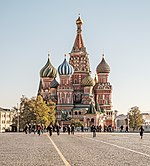The United Nations Educational, Scientific and Cultural Organization (UNESCO) World Heritage Sites are places of importance to cultural or natural heritage as described in the UNESCO World Heritage Convention, established in 1972. [1] Cultural heritage consists of monuments (such as architectural works, monumental sculptures, or inscriptions), groups of buildings, and sites (including archaeological sites). Natural features (consisting of physical and biological formations), geological and physiographical formations (including habitats of threatened species of animals and plants), and natural sites which are important from the point of view of science, conservation or natural beauty, are defined as natural heritage. [2] The Soviet Union, officially the Union of Soviet Socialist Republics (USSR), ratified the convention on 12 October 1988. [3] Five sites, all cultural, were inscribed at the 14th session of the UNESCO World Heritage Committee, held in Banff, Alberta, Canada, in 1990. The Soviet Union collapsed a year later and management of all the sites are continued by the successor states: three in Russia, and one each in Ukraine and Uzbekistan. [4]










